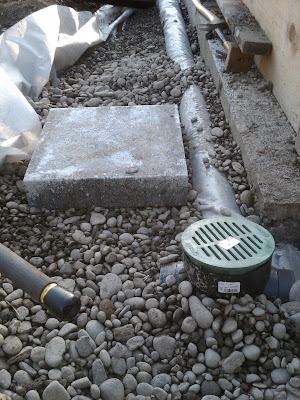I think the Janus-faced water cycle of this locale is tough to plan for. We basically have two strikingly different seasons: wet and dry. Making water work in both seasons is tricky.
In the case of my largely flat lot, gettting dried out enough to plant in Spring and early Summer is difficult. Clearly, strategies like forest gardening, using perennials, etc. help. However, much simply has to be done with the grade in order to make things workable. In general, in my case, that meant raising the level of the beds above the lot by about a foot overall.
But, here's the rub: now in dry season things drain out super fast thereby increasing my water demands.
The basic structure of my water situation is this:
- beds highest
- paths just below them,
- porous drainage below paths,
- baseline waterline below all of that
This is working OK, but if I water heavily (soaker hoses) I've observed that water ultimately finds the drainage below the path and travels away from the beds faster than I like, almost always before the entire bed is hydrated. So, it's inefficient in some measure.
So, here's an alternative layout I'm considering:
- Paths highest
- Porous drainage below paths
- Beds just below that
- Basedline waterline below all of that
What would this do? First, during we season the beds are sill above natural waterline of the lot which would keep them dry enough to plant early. Second, because the drainage is above the beds, the beds get the water first and the drainage acts only as overflow management which is really ideal and would (I think) help hydrate the lot in the long-term. As an added bonus, the paths above the beds make it easier to keep soil out of the paths.
One more water thing I'm puzzling over this summer: crowned versus panned beds. Crowning makes for a gentler angle of repose for the soil than panning, but sheds water faster too. Pans have steep sides which tend to fall down unless rooted in place, but also make watering a snap because they retain water long enough for it to seep in.
I'm experimenting.
